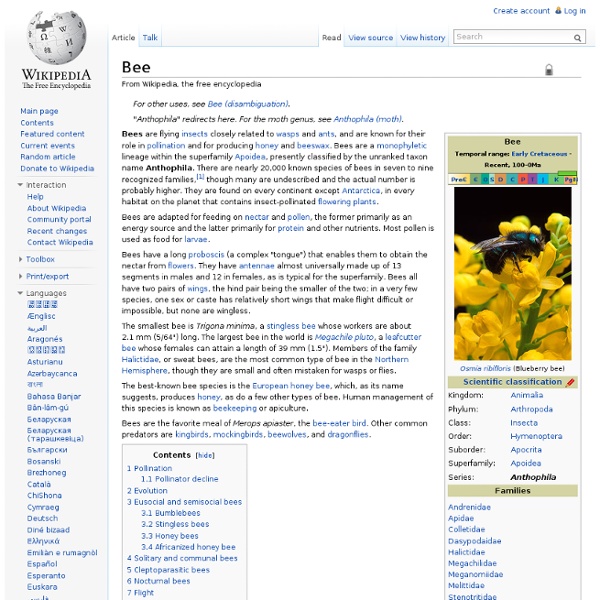Bee

Conserving Bees - International Bee Research Association
Conserving our bees by Robert Paxton The title of this article, reflects a growing awareness and interest in the demise of the world's wild bees, and the impact this may have on other wildlife, ecosystems (including agroecosystems) and the world's economy. The Red Data Book contains a high percentage of the bee species considered to be under threat. Many bee species appear threatened with extinction, with the general consensus of opinion falling on humans as the culprits, through their degradation and destruction of habitats. I see three major arguments for the conservation of wild bees, namely: Bees are of conservation value in their own right, as a component of the world's biodiversity.Bees are important components of natural ecosystems and play a big role in their functioning. Bees for bees' sake There is a need to know which species are rare, and which are changing in abundance. Bees and the wider wildlife Bees and agriculture References 1. 2. 3. 4. 5. 6. 7. 9. 10. 11. 12. 13.
RANDOM FLAMING DRAGON
Owl
Owls hunt mostly small mammals, insects, and other birds, although a few species specialize in hunting fish. They are found in all regions of the Earth except Antarctica and some remote islands. Anatomy[edit] Owls have large forward-facing eyes and ear-holes; a hawk-like beak; a flat face; and usually a conspicuous circle of feathers, a facial disc, around each eye. Owls can rotate their heads and necks as much as 270 degrees. Different species of owls make different sounds; this wide range of calls aids owls in finding mates or announcing their presence to potential competitors, and also aids ornithologists and birders in locating these birds and recognizing species. Breeding and reproduction[edit] Owl eggs usually have a white color and an almost spherical shape, and range in number from a few to a dozen, depending on species and the particular season; for most, three or four is the more common number. Behavior[edit] Most owls are nocturnal, actively hunting their prey only in darkness.
The Barn Owl Trust
Bird of prey
Birds of prey, also known as raptors, hunt and feed on other animals. The term "raptor" is derived from the Latin word rapere (meaning to seize or take by force).[1] These birds are characterized by keen vision that allows them to detect prey during flight and powerful talons and beaks. In most cases, the females are larger than the males. Because of their predatory nature, they face distinct conservation concerns. Definition[edit] Classification by ancestry[edit] Strigidae: (typical owls)Tytonidae: (barn and bay owls). The observation that otherwise unrelated bird groups may perform similar ecological roles and bear striking morphological similarities to one another is explained by the concept of convergent evolution. Common names[edit] The common names for various birds of prey are based on structure, but many of the traditional names do not reflect the evolutionary relationships between the groups. Variations in shape and size See also[edit] References[edit] Jump up ^ Brown, Leslie (1997).
Related:
Related:



